Image Design Question
If you think you know why I placed the owl a lot closer to the center of the frame than I usually do, please leave a comment.
What’s Up?
Today is Monday 6 December 2021. It is oh-dark hundred and I am on the way to Stick Marsh with Jim driving. I have no idea what to expect. I did write the USFWS yesterday with regards to the permit they issued for the dike reconstruction project at Fellsmere Grade Recreation Area. I hope to hear from them early this week. I recorded the Saving the Whites video yesterday and will finish editing it before this blog post is published so that Jim can get it into the store for your purchasing pleasure. Wherever you are, and whatever you are doing, I hope that you too have a great day. This blog post took about an hour to prepare and makes 27 consecutive days with a new one.
Please remember that you can find some great photo accessories (and necessities, like surf booties!) on Amazon by clicking on the Stuff tab on the orange/yellow menu bar above. On a related note, it would be extremely helpful if blog-folks who, like me, spend too much money on Amazon, would get in the habit of clicking on the Amazon logo link on the right side of each blog post when they shop online. As you might expect, doing so will not cost you a single penny, but would be appreciated tremendously by yours truly. And doing so works seamlessly with your Amazon Prime account.
Please remember that if an item — a Delkin flash card, or a tripod head — for example, that is available from B&H and/or Bedfords, is also available in the BAA Online Store, it would be great, and greatly appreciated, if you would opt to purchase from us. We will match any price. Please remember also to use my B&H affiliate links or to save 3% at Bedfords by using the BIRDSASART discount code at checkout for your major gear purchases. Doing either often earns you free guides and/or discounts. And always earns my great appreciation.
|
|
The Saving the WHITEs (and lots more!) Video image |
The Saving the Whites (and lots more!) Video
My two biggest challenges when optimizing images are getting the BLUEs just right, and restoring detail to the WHITEs and highlights of properly exposed raw files. There are four things that I do to accomplish the latter. All are covered in detail in this 21+ minute video, along with a dirty trick to try if the first four do not work perfectly. Sit with me at my laptop as I teach you how to save the WHITEs. I begin with the raw conversions of two different raw files, today’s featured Snowy Owl image, and Joe Usewicz’s spoonbill image that was featured in the Extraordinary Over-Exposed (?) Spoonbill/Saving the WHITEs Optimization blog post here.
In addition to learning how to save the WHITEs (in both images), you will learn how to expand canvas using the amazingly convenient Content-Aware Crop Tool, to set the White Balance (color temperature), to set the WHITE and BLACK points, see Digital Eye Doctor and RawDigger in action, learn to make a Color Range Selection, and lots more.
To purchase your copy of the Saving the Whites Video (and lots more!) video, you can send a PayPal for $37.00 to us at birdsasart@verizon.net, call Jim in the office at 863-692-0906 with your credit card in hand, or visit the item in the BAA Online store by clicking here.
After clicking on each image, check out the nice detail in the white face of the owl in the optimized version (Image #1), with the virtually absent detail in the face of the owl in the Photo Mechanic screen capture (Image #1A). As I have been saying here often for two decades, properly exposed raw files will often appear washed out with little detail in the highlights …
Brand New and As-Good-As-Ever Bedfords BAA Discount Policy
Folks who have fallen in love with Bedfords can now use the BIRDSASART coupon code at checkout to enjoy a post-purchase, 3% off-statement credit (excluding taxes and shipping charges) on orders paid with a credit card. The 3% credit will be refunded to the card you used for your purchase. Be sure, also, to check the box for free shipping to enjoy free Second Day Air Fed-Ex. This offer does not apply to purchases of Classes, Gift Cards, and any prior purchases.
Money Saving Reminder
Many have learned that if you need a hot photo item that is out of stock at B&H and would like to enjoy getting 3% back on your credit card along with free 2nd Day Air Fed-Ex Air shipping, your best bet is to click here, place an order with Bedfords, and enter the coupon code BIRDSASART at checkout. If an item is out of stock, contact Steve Elkins via e-mail or on his cell phone at (479) 381-2592 (Central time). Be sure to mention the BIRDSASART coupon code and check the box for Free Shipping. That will automatically upgrade to free 2nd Day Air Fed-Ex. Steve has been great at getting folks the hot items that are out of stock at B&H and everywhere else. The wait lists at the big stores can be a year or longer for the hard to get items. Steve will surely get you your gear long before that. For the past year, he has been helping BAA Blog folks get their hands on items like the SONY a 1, the SONY 200-600 G OSS lens, the Canon EOS R5, the Canon RF 100-500mm lens, and the Nikon 500mm PF. Steve is personable, helpful, and eager-to-please.
Important Note
As an Amazon Associate, I earn a small percentage when you purchase from Amazon after using any of the links on the blog (including the logo-link immediately above). My link works with Amazon Prime and using it will not cost you a single cent. Huge thanks, BTW 🙂
Please Remember Also
Please, if you enjoy and learn from the blog, remember to use one of my two affiliate programs when purchasing new gear. Doing so just might make it possible for me to avoid having to try to get a job as a Walmart greeter and will not cost you a single penny more. And if you use Bedfords and remember to enter the BIRDSASART code at checkout, you will (still!) save 3% on every order and enjoy free second-day air shipping. In these crazy times — I lost about fifty thousand dollars in income due to COVID 19 — remembering to use my B&H link or to shop at Bedfords will help me out a ton and be greatly appreciated. Overseas folks who cannot order from the US because of import fees, duties, and taxes, are invited to help out by clicking here to leave a blog thank you gift if they see fit.


Gear Questions and Advice
Too many folks attending BAA IPTs and dozens of photographers whom I see in the field and on BPN, are–out of ignorance–using the wrong gear, especially when it comes to tripods and more especially, tripod heads… Please know that I am always glad to answer your gear questions via e-mail. If you are desperate, you can try me on my cell at 863-221-2372. Please leave a message and shoot me a text if I do not pick up.
|
|
|
This image was created on 30 November 2021 at Westhampton Beach, Long Island, NY. Standing, I used the (no longer available) Induro GIT304L Grand Series 3 Stealth Carbon Fiber Tripod / Levered-Clamp FlexShooter Pro-mounted-supported Sony FE 600mm f/4 GM OSS lens and The One, the Sony Alpha 1 Mirrorless Digital Camera.. ISO 800. The exposure was determined by Zebras with ISO on the rear wheel: 1/320 sec. at f/4 (wide open) in Manual mode. AWB at 7:05am on cold, clear morning . Tracking: Spot S with Bird-Eye/Face Detection performed perfectly by tracking and nailing the bird’s left eye. Click on the image to enjoy the high-res version. Image #1: Snowy Owl on dune in early morning light |
The 2nd Best Snowy Owl Image From My Northeast Trip?
This image was made possible only because I employed the in-the-field skills that I have honed over the past 38+ years (he said humbly …) Just for the record, it was a clear and cold 24°. With the bird up on top of a dune, its face was blocked by grasses. The only way to get the shot was to carefully make my way halfway up the dune without disturbing the owl. I was confident that I could do just that. Because I would be going uphill, I shortened the front leg of my tripod before approaching. I moved super-slowly, keeping my tripod low and in front of me. I successfully inched my way forward, got taller, and made a short series of bracketed images. Then I retreated, leaving the owl just where I had found it.
|
|
Image #1A:The Photo Mechanic screen capture for the Snowy Owl on dune in early morning light image |
Photo Mechanic
I’ve used and loved Photo Mechanic as my image browser for well more than a decade now. It is lightning fast, has a great zoom feature, and enables me to tag my keepers quickly and efficiently and then to safely delete the untagged rejects. The fact that the histogram is not quite perfect does not bother me at all. Why? None of the several other histograms that too many folks rely on are accurate. Only the Adapted “pink” RawDigger Histogram allows you to properly evaluate the exposure or brightness of your raw files. Scroll down for more on RawDigger.
The histogram here shows that the RED channel is clearly over-exposed. RawDigger reveals the truth: the RED channel is not over-exposed at all.
|
|
Image #1B: The RawDigger screen capture for the Snowy Owl on dune in early morning light image |
Dead-Solid Perfect!
Images like the one in the screen capture here, where the G channel gets 2/3rds of the way from the 8000 to the 16000 line, are perfect exposures. Images where the G channel gets right up to the 16000 line are dead-solid perfect. With a grand total of eight OvExp pixels out of 51,000,000, this is a perfect exposure. (Scroll down to see the eight OvExp pixels.)
RawDigger — not for the faint of heart …
Nothing has ever helped me learn to create perfect exposures to the degree that RawDigger has. I think that many folks are reluctant to learn that most of their images are underexposed by one or more full stops and that highlight warnings in Photoshop, Lightroom, Capture One, and your in-camera histogram are completely bogus as they are based on the embedded JPEGs. Only your raw files tell the truth all the time. Heck, I resisted RawDigger for several years … Once you get over that feeling, RawDigger can become your very best exposure friend no matter what system you are using. On the recent IPTs and In-the-Field sessions, we have demonstrated that fact. Convincingly.
The RawDigger (pink) Adapted Histogram
In the RawDigger e-Guide, you will learn exactly how to set up the Adapted “pink” RawDigger Histogram and how to use it to quickly and easily evaluate the exposure or raw file brightness of images from all digital cameras currently in use. RawDigger was especially helpful to me when I struggled with R5 exposures and when learned my new camera body, the Sony Alpha a1.
|
|
Image #1C: The RawDigger screen capture at 700% for the Snowy Owl on dune in early morning light image |
The Specular Highlights
Enlarging the image to 700% clearly shows us that the eight OvExp pixels are in the specular nightlights in the owl’s eye. Trying to avoid over-exposed specular highlight will yield images that are many, many stops under-exposed.
|
|
RawDigger e-Guide with Two Videos |
The RawDigger e-Guide with Two Videos
by Arthur Morris with Patrick Sparkman
The RawDigger e-Guide was created only for serious photographers who wish to get the absolute most out of their raw files.
Patrick and I began work on the guide in July 2020. At first we struggled. We asked questions. We learned about Max-G values. We could not figure out why the Max G values varied by camera system. IPT veteran Bart Deamer asked lots of questions that we could not answer. We got help from RawDigger creator Iliah Borg. We learned. In December, Patrick came up with an Adapted Histogram that allows us to evaluate the exposures and raw file brightness for all images created with all digital camera bodies from the last two decades. What we learned each time prompted three complete beginning to end re-writes.
The point of the guide is to teach you to truly expose to the mega-Expose-to-the-Right so that you will minimize noise, maximize image quality, best utilize your camera’s dynamic range, and attain the highest possible level of shadow detail in your RAW files in every situation. In addition, your properly exposed RAW files will contain more tonal information and feature the smoothest possible transitions between tones. And your optimized images will feature rich, accurate color.
We teach you why the GREEN channel is almost always the first to over-expose. We save you money by advising you which version of RawDigger you need. We teach you how to interpret the Max G values for your Canon, Nikon, and SONY camera bodies. It is very likely that the Shock-your-World section will shock you. And lastly — thanks to the technical and practical brilliance of Patrick Sparkman — we teach you a simple way to quickly and easily evaluate your exposures and raw file brightness using an Adapted RawDigger histogram.
The flower video takes you through a session where artie edits a folder of images in Capture One while checking the exposures and Max-G values in RawDigger. The Adapted Histogram video examines a series of recent images with the pink histograms and covers lots of fine points including and especially how to deal with specular highlights. The directions for setting up the Adapted Histogram are in the text.
If we priced this guide based on how much effort we put into it, it would sell it for $999.00. But as this guide will be purchased only by a limited number of serious photographers, we have priced it at $51.00. You can order yours here in the BAA Online Store.
Typos
With all blog posts, feel free to e-mail or to leave a comment regarding any typos or errors.

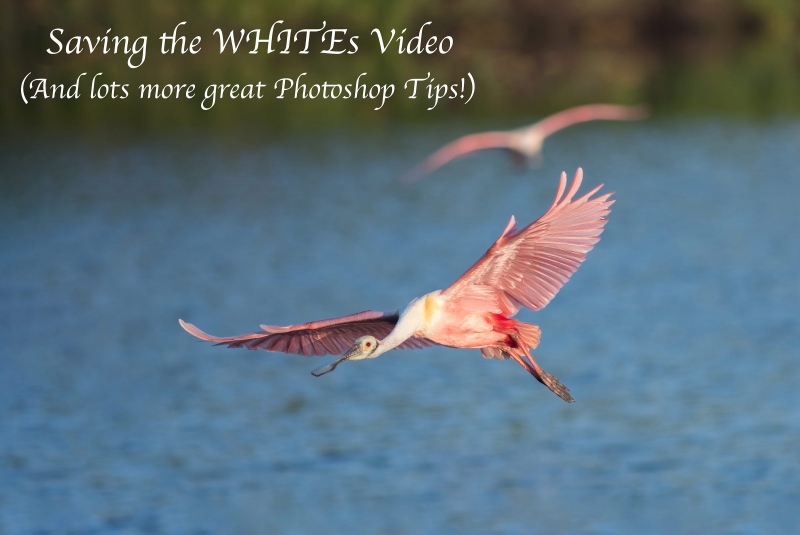

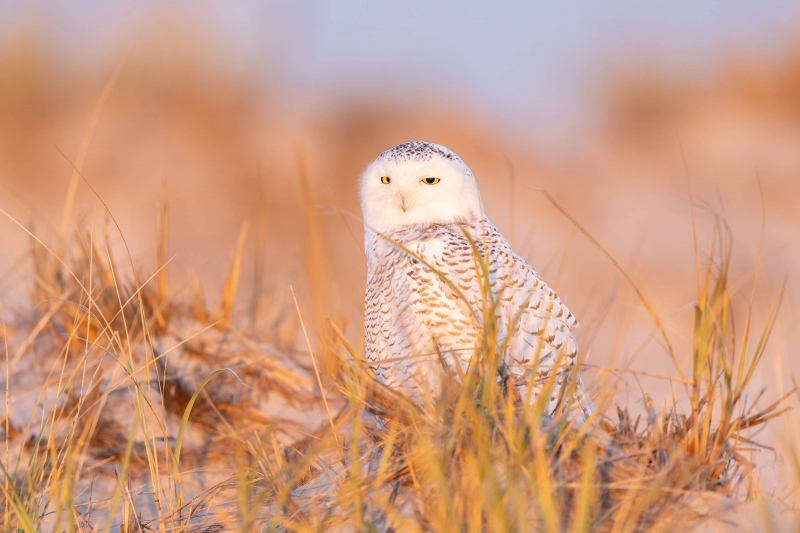
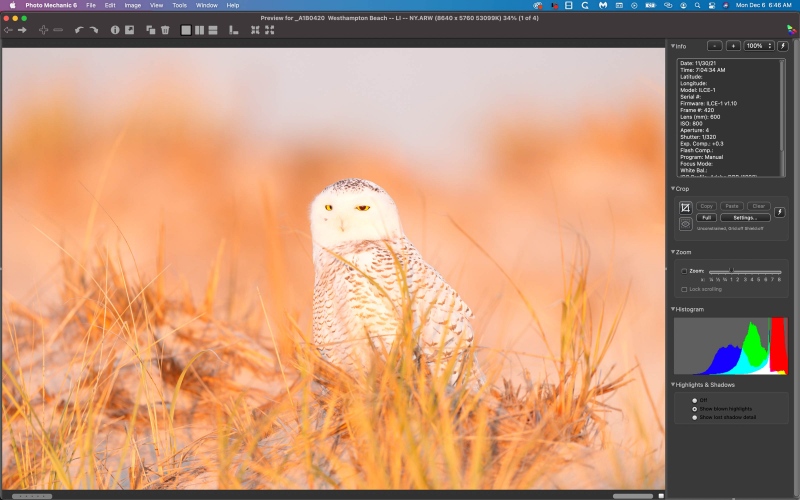
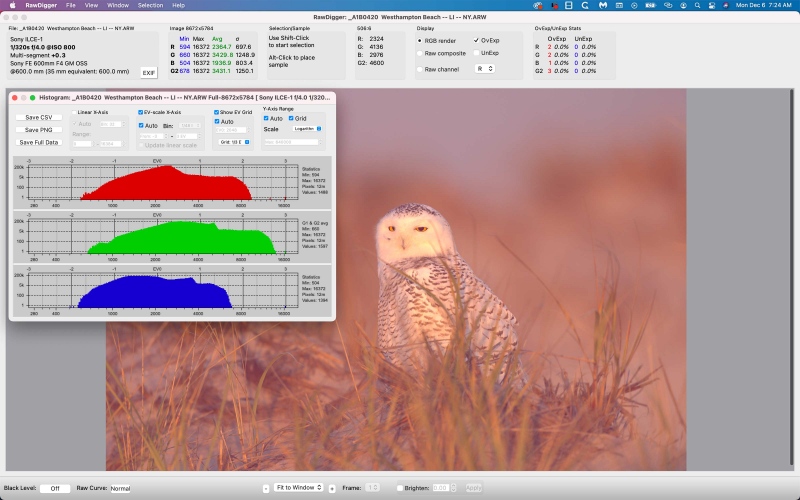
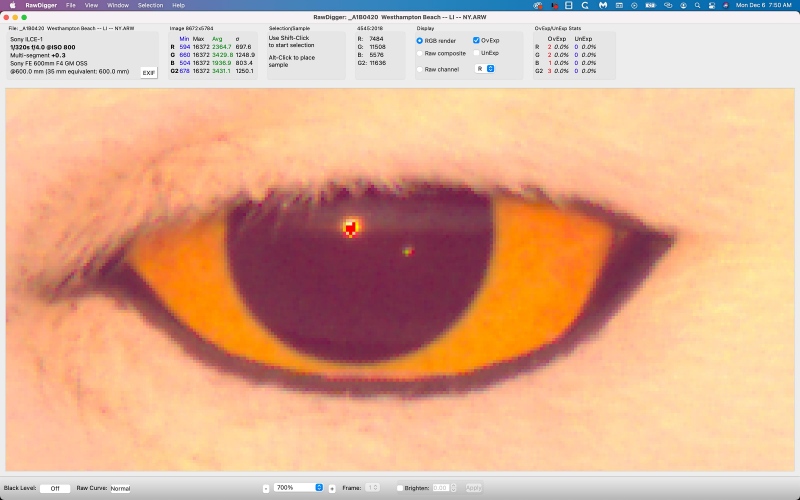














Can’t say why you centered the owl, but it looks perfect. In a long ago book, Tim Fitzharris had a photo of an American Bittern showing all sorts of layers of composition–near foreground, middle foreground, in-plane vegetation, near background, distant background, sky, corner anchors, etc., etc. This photo has all of that, and it all frames the bird wonderfully. Love the way the dune rises to our left, the way the owl’s head doesn’t merge with the sky, how the weight of the OOF grasses in front of the bird balance the dune on the left. Sweet.
Thanks a stack, Cliff. The key was to be able to get halfway up the dune without flushing the bird. From below, the bird was completely blocked and there was no shot.
with love, artie
Showing the grass on the right side balances the image better then cropping it out. Beautiful image!
The vertical grasses to the right add balance to the scene. Also, had you framed to crop them out you’d be left with the large, diagonal grass that, now floating, would need to be cloned out.
You placed the Owl close to the center of the frame so the muted background colors would let the white of the owl “pop” and so the grasses would not obstruct the eyes. Love the image.
Wonderful image, Artie. I love the background setting (the dry grasses) which makes it feel like we’re observing this owl in its natural state. Congratulations.